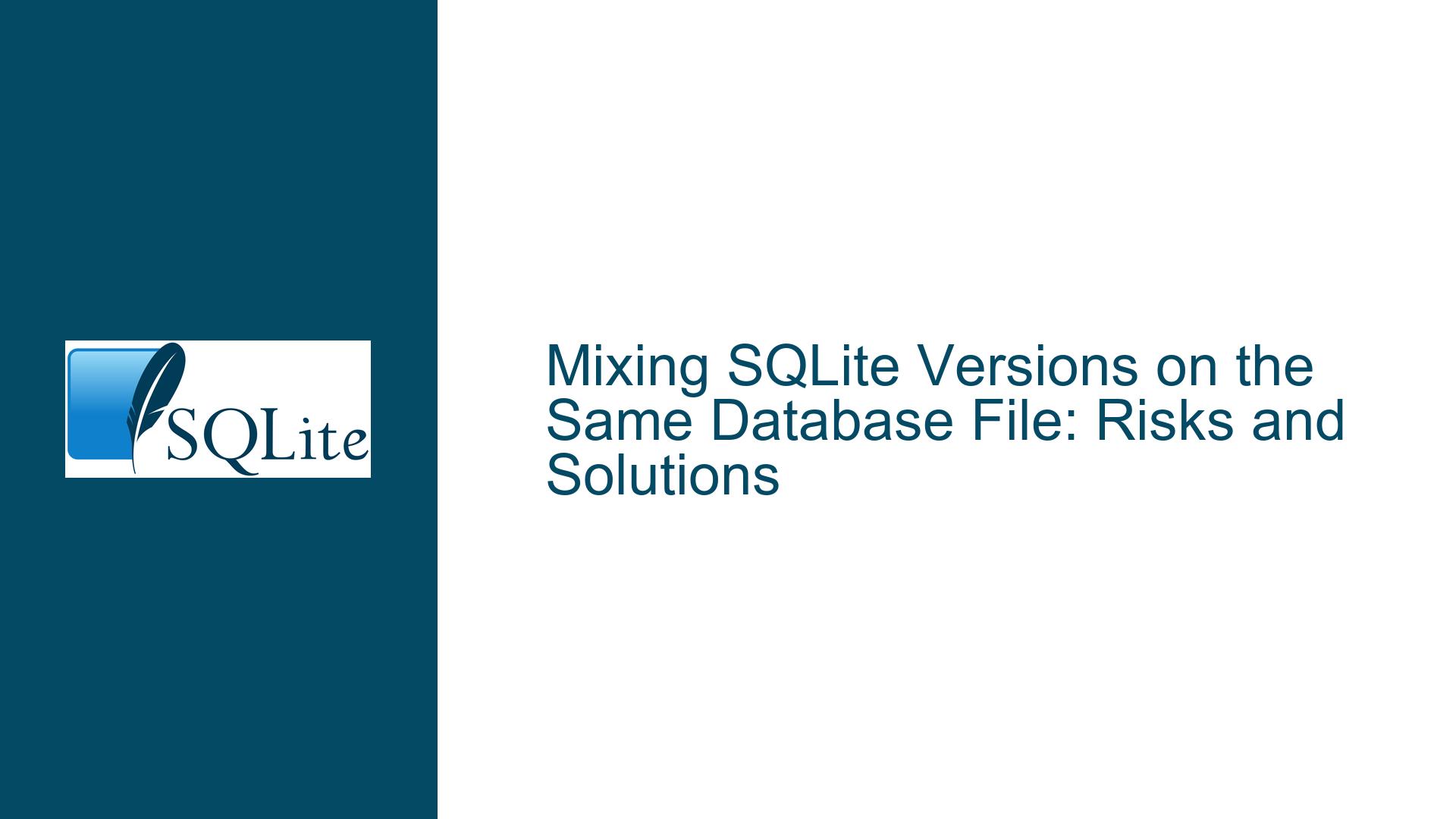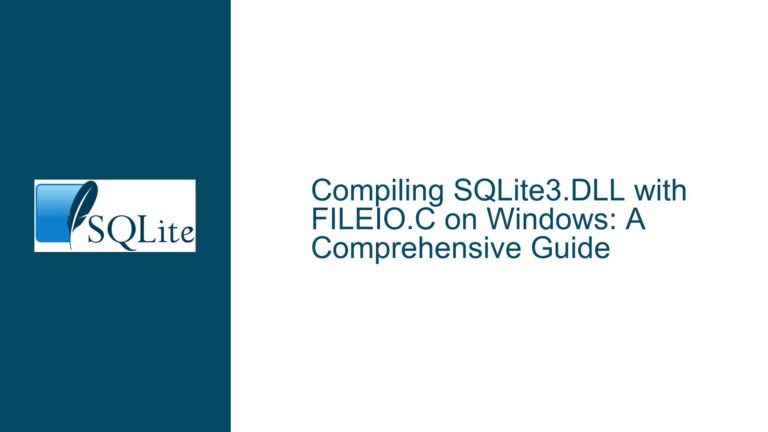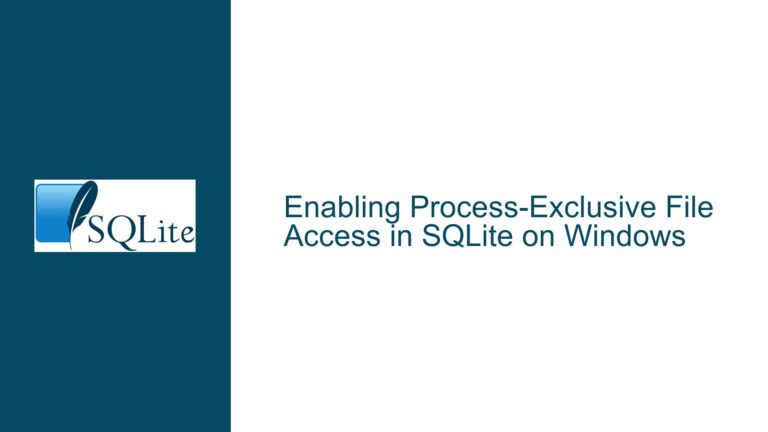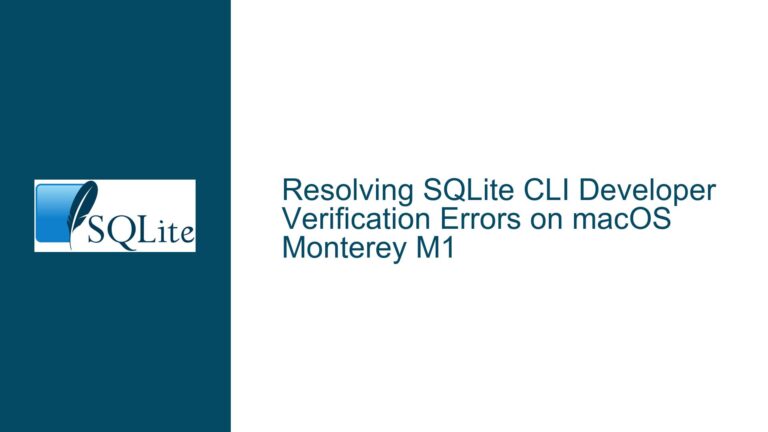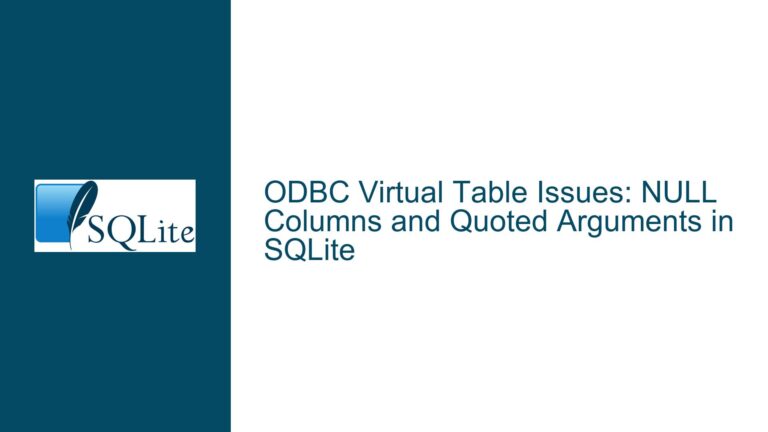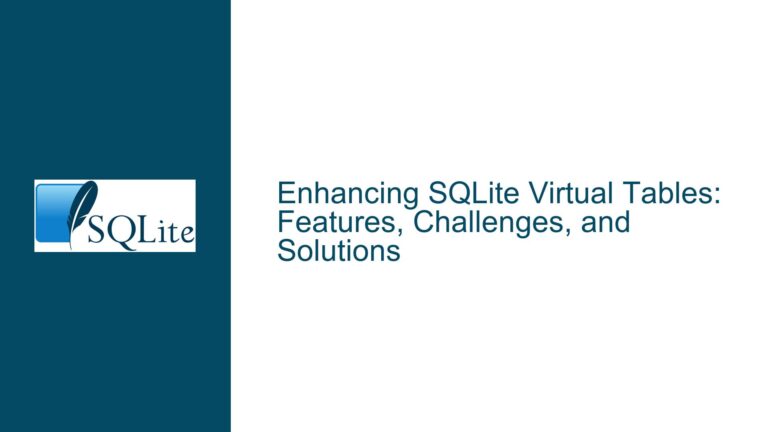Mixing SQLite Versions on the Same Database File: Risks and Solutions
Understanding the Risks of Mixing SQLite Versions in a Single Database Environment
When working with SQLite databases, one of the most common yet overlooked challenges is the mixing of different SQLite library versions within the same database environment. This scenario often arises in modern development workflows, particularly when using containerized applications (e.g., Docker) alongside host systems or when employing third-party libraries that bundle their own SQLite versions. While SQLite is designed to be highly backward-compatible, mixing versions can introduce subtle risks that may compromise database integrity, performance, or functionality.
The core issue revolves around the compatibility of database file formats, locking mechanisms, and feature sets across different SQLite versions. For instance, a database file created or modified by a newer version of SQLite (e.g., 3.34) might utilize features or optimizations unavailable in an older version (e.g., 3.22). While SQLite strives to maintain backward compatibility, certain edge cases—such as bugs, file format changes, or locking behavior—can lead to unexpected behavior when multiple versions interact with the same database file.
This post delves into the nuances of mixing SQLite versions, exploring the potential causes of issues, and providing actionable troubleshooting steps and solutions to mitigate risks. By understanding the underlying mechanisms and adopting best practices, you can ensure a stable and reliable database environment even when multiple SQLite versions are in play.
Potential Causes of Issues When Mixing SQLite Versions
The risks associated with mixing SQLite versions stem from several key factors, each of which can manifest in different ways depending on the specific versions involved and the nature of the database operations. Below, we explore the primary causes of these issues in detail.
1. File Format and Feature Compatibility
SQLite databases are designed to be forward and backward compatible within the same major version (e.g., all 3.x versions). However, newer versions of SQLite may introduce optimizations, file format changes, or new features that are not supported by older versions. For example, SQLite 3.34 introduced enhancements to the Write-Ahead Logging (WAL) mode and query optimizations that are not present in SQLite 3.22. If a newer version writes to the database using these features, an older version may fail to interpret the changes correctly, leading to errors or data corruption.
While SQLite’s design philosophy ensures that such changes are rare and carefully managed, the possibility of encountering unsupported features increases when the version gap is significant. This is particularly relevant when using third-party libraries or frameworks (e.g., Diesel) that may inadvertently introduce newer SQLite features without explicit user awareness.
2. Locking Mechanisms and File System Behavior
SQLite relies on file system locks to manage concurrent access to the database. However, the implementation of these locks can vary between versions, especially when dealing with advisory locks in POSIX-compliant systems. When multiple versions of SQLite access the same database file, differences in locking behavior can lead to race conditions, deadlocks, or even data corruption.
For instance, SQLite 3.35 introduced a bug in the handling of WAL mode that was later fixed in 3.37.2. If one version of SQLite (e.g., 3.34) uses WAL mode while another (e.g., 3.22) does not, the interaction between these versions can trigger the bug, resulting in database corruption. Additionally, containerized environments (e.g., Docker) can exacerbate locking issues due to differences in how file systems are mounted and shared between the host and container.
3. Third-Party Libraries and Framework Dependencies
Many applications rely on third-party libraries or frameworks (e.g., Diesel, SQLAlchemy) to interact with SQLite databases. These libraries often bundle their own versions of SQLite, which may differ from the system-wide version or the version used in other parts of the application. This introduces an additional layer of complexity, as the behavior of the database may vary depending on which version of SQLite is active at any given time.
For example, a library that uses SQLite 3.34 might enable features like strict typing or enhanced query optimizations, which are not supported by SQLite 3.22. If the application or another library attempts to access the database using the older version, it may encounter errors or unexpected behavior. This is particularly problematic in long-running applications where the database schema or usage patterns evolve over time.
4. Containerized Environments and Version Mismatches
Containerized environments, such as Docker, are a common source of SQLite version mismatches. In these environments, the application running inside the container may use a different version of SQLite than the host system or other containers. This can lead to inconsistencies in database access, especially when the database file is shared between the container and the host.
For example, if the container uses SQLite 3.34 and the host uses SQLite 3.22, the host may not be able to interpret certain database operations performed by the container. This can result in errors, data corruption, or performance degradation. Additionally, containerized environments often use overlay file systems or bind mounts, which can introduce additional complexities in file locking and access patterns.
Troubleshooting Steps, Solutions, and Fixes for Mixed SQLite Version Issues
To mitigate the risks associated with mixing SQLite versions, it is essential to adopt a proactive approach that addresses potential issues before they arise. Below, we outline a comprehensive set of troubleshooting steps, solutions, and fixes to ensure a stable and reliable database environment.
1. Standardize SQLite Versions Across All Environments
The most effective way to avoid issues caused by version mismatches is to standardize the SQLite version used across all environments, including containers, host systems, and third-party libraries. This ensures that all components interacting with the database share a consistent view of its structure and behavior.
To achieve this, consider the following steps:
- Audit SQLite Versions: Identify the SQLite versions used in all parts of your application, including containers, host systems, and third-party libraries. Tools like
ldd(Linux) orotool(macOS) can help determine the linked SQLite version in binaries. - Align Versions: Update all components to use the same version of SQLite. This may involve recompiling third-party libraries or upgrading the SQLite version in your containers and host systems.
- Test Compatibility: After standardizing the SQLite version, thoroughly test your application to ensure that all database operations function as expected. Pay special attention to edge cases, such as concurrent access and schema migrations.
2. Avoid Using New Features in Mixed-Version Environments
If standardizing SQLite versions is not feasible, avoid using features introduced in newer versions of SQLite when working in a mixed-version environment. This reduces the likelihood of encountering compatibility issues when older versions access the database.
To implement this strategy:
- Review Release Notes: Familiarize yourself with the features and changes introduced in each SQLite version. The SQLite website provides detailed release notes for every version.
- Disable Unsupported Features: If your application or library uses newer SQLite features, consider disabling them or providing fallback mechanisms for older versions. For example, avoid using strict typing or enhanced query optimizations if they are not supported by all versions in your environment.
- Monitor for Errors: Implement robust error handling and logging to detect and address compatibility issues as they arise. This can help you identify and mitigate problems before they escalate.
3. Implement Robust File Locking and Concurrency Controls
Differences in file locking behavior between SQLite versions can lead to race conditions, deadlocks, or data corruption. To minimize these risks, implement robust file locking and concurrency controls in your application.
Consider the following best practices:
- Use WAL Mode Judiciously: Write-Ahead Logging (WAL) mode can improve concurrency and performance, but it may introduce compatibility issues in mixed-version environments. If you use WAL mode, ensure that all SQLite versions in your environment support it and are free of known bugs.
- Test Locking Behavior: Conduct thorough testing to verify that file locking works as expected across all SQLite versions and environments. This is especially important in containerized setups, where file system behavior may differ from traditional environments.
- Implement Retry Logic: In cases where locking issues are unavoidable, implement retry logic in your application to handle transient errors gracefully. This can help mitigate the impact of race conditions or deadlocks.
4. Isolate Database Access in Containerized Environments
Containerized environments introduce additional complexities when mixing SQLite versions. To minimize these risks, isolate database access to a single environment or implement safeguards to prevent version mismatches.
Here are some strategies to consider:
- Use a Dedicated Database Container: Instead of sharing the database file between the host and container, run a dedicated database container that uses a consistent SQLite version. This ensures that all database operations are performed by the same version of SQLite.
- Avoid Bind Mounts for Database Files: Bind mounts can introduce file system inconsistencies and locking issues. Instead, use Docker volumes or other storage solutions that provide consistent behavior across environments.
- Monitor Container-Host Interactions: If you must share the database file between the host and container, monitor interactions closely to detect and address version mismatches or locking issues.
5. Leverage SQLite’s Backward Compatibility Safeguards
SQLite is designed to be highly backward compatible, with extensive testing to ensure that older versions can read and write databases created by newer versions. Leverage these safeguards to minimize the risks of mixing versions.
To make the most of SQLite’s backward compatibility:
- Stick to Core Features: When working in a mixed-version environment, stick to core SQLite features that are supported across all versions. Avoid using experimental or version-specific features unless absolutely necessary.
- Test Across Versions: Regularly test your application with all SQLite versions in your environment to ensure compatibility. This can help you identify and address issues before they impact production systems.
- Stay Informed: Keep up to date with SQLite’s development and release cycles. This will help you anticipate and prepare for any changes that may affect your application.
By following these troubleshooting steps and solutions, you can effectively mitigate the risks associated with mixing SQLite versions in a single database environment. Whether you’re working with containerized applications, third-party libraries, or legacy systems, a proactive and informed approach will help you maintain a stable and reliable database infrastructure.
